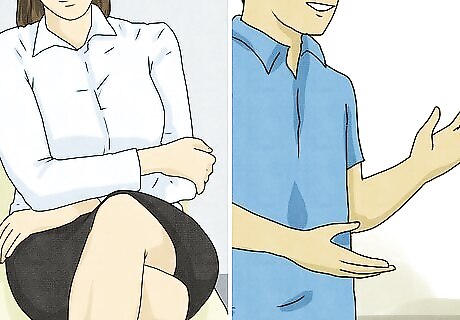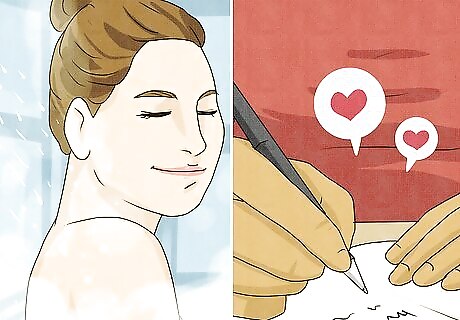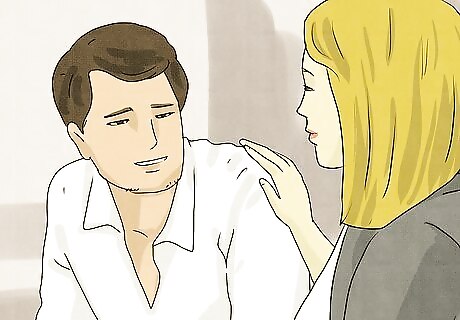
views
Challenge negative thoughts.

Your automatic thought process influences how you see the world. When you have a fearful avoidant attachment style, you often think badly about yourself and those around you. Try to catch those thoughts and challenge them with new, positive thinking to slowly work toward a more secure attachment style and positive outlook on life. If you think, “No one will ever love me,” challenge it with something like, “I am worthy of love, and I will find it one day.” If you think, “Everyone only wants to take advantage of me,” challenge it with, “My friends and family love me for who I am, not for what I can give them.” Neither positivity nor negativity exist in a vacuum. There's always positivity around you—you just have to be willing to seek it out and give voice to it.
Express your feelings.

Identifying your emotions helps give you power over them. When you have an avoidant attachment style, you probably shy away from your feelings or block them off entirely. Instead, try to name the emotion and then express it—it will help you communicate much better. “I’m feeling sad right now because you snapped at me today.” “I feel a little angry because you didn’t keep your promise.” “I feel really anxious right now because I’m overwhelmed.” You can start sharing what you feel more openly and authentically with your partner. It will help you work out of the avoidant style and towards a more secure place where you can say that it is okay to share your emotions and what is going on with you. It is alright to rely on someone else to soothe you, help you feel better, or help you address what is going on with you.
Open up your body language.

You may be closing yourself off to others nonverbally without realizing it. When you have a fearful avoidant attachment style, you may be signaling to others that you’re not interested in connecting with them, even if you don’t mean to. Try to make eye contact with other people, keep your head held high, and uncross your arms. These small changes will make you look more approachable, and they can really help strengthen your relationships. Try to pick out these nonverbal cues in other people, too. When someone is sad, do they cross their arms and turn away from you? When someone is happy, do they look right at you and sit up straight?
Raise your self-esteem.

People with fearful avoidant attachment styles often have low self-esteem. Your self-esteem can affect your relationship with others, and it can make you feel like you aren’t worthy of love. By raising your self-esteem, you can take control of your life and feel like you have power over your own decisions. Some good ways to raise your self-esteem include: Celebrating your successes, both big and small Doing hobbies and activities you enjoy Setting (and achieving) small goals Doing something nice for yourself every day Eating a healthy diet and getting plenty of exercise Writing a list of things you like about yourself
Practice mindfulness.

Stay present in the moment to avoid succumbing to fear. When you have an avoidant attachment style, it can be easy to start worrying about the future (or get stuck in thoughts from the past). If you notice yourself doing that, try to stay grounded, and notice everything around you. Keep focusing on what’s happening now, not what might happen in the future. An easy way to stay in the moment is to use all 5 of your senses. When you catch yourself drifting off, try naming one thing you can taste, touch, smell, hear, and see. Try to maintain a grounded, humble perspective about life. In both good times and bad, this perspective can help you remember who you are and help you realize that life is good.
Spend time with your loved ones.

The people you love can prove that you can rely on others. If you haven’t been able to depend on the people in your life very much, try to find friends who will stick with you no matter what. Hang out with them often and do things together that make you happy to improve your thoughts about other people. Since a fearful avoidant attachment style can make you see the worst in people, it’s good to find loved ones that you see in a positive light. If you don’t have a ton of friends right now, that’s okay. It’s common for fearful avoidant attachment styles to shy away from close relationships. Try seeking out like-minded people by joining a group or a club that you’re interested in.
Accept others for who they are.

Human beings are flawed, and that’s okay. When you have a fearful avoidant attachment style, you can sometimes spend a long time searching for the perfect person. However, everyone has their own demons to deal with, and you’re never going to find someone that doesn’t have problems. Try to accept that your loved ones and partners will have flaws, just like you. It can be helpful to compare someone else’s flaws to what they do well. If you catch yourself judging someone else, try thinking, “Sure, they might never be on time, but at least they always remember to text me back.” You can also look for the deeper meaning within your own judgment. For instance, when your friend is late, does it make you feel uncared for? If so, you can work through those emotions and recognize that their lateness has nothing to do with you.
Define your boundaries.

Understand your own boundaries so that you can assert them. What are you comfortable with in a relationship? What are you not comfortable with? For a lot of people with a fearful avoidant attachment style, the boundaries are there, but they’re hard to express. When you tell other people about your boundaries, they can respect them, which leads to a more positive relationship. Sit down and think about your emotions, your thoughts, and your values so that you can express yourself clearly and accurately. For instance, how much alone time do you need? What are some topics you’re not willing to discuss? What are your values? What do you care most deeply about?
Talk to your partner.

If you have a partner, tell them what you’ve been doing about your attachment style. They might be able to give you some words of advice or even some encouragement. Share with them what you know about your attachment style, what you’ve been doing to work through it, and what they might be able to do to help you out. “You’ve probably noticed that I seem a little preoccupied lately. I’m really trying to work on my attachment style and reach a healthier level with my self-esteem. It would mean a lot if I could share with you what I’m doing and how I’m working on things.”
Get close to someone with a secure attachment.

You can model your attachment style off of someone else’s. The good news is that 50% to 60% of the population has a secure attachment style, so you probably know someone who fits the bill already. Try to watch them and see how they handle their emotions and their relationships, then do the same thing in your own life. When they get upset, do they shut down and close themselves off? Or do they state their emotions and communicate them clearly? When they get rejected, do they take it personally? Or do they brush it off and try again?
Make an appointment with a mental health professional.

Getting therapy is the best way to work through your attachment style. Since a fearful avoidant attachment style is so deeply rooted in trauma, it’s important to talk about it with someone you trust. A mental health professional can help you identify where your attachment style comes from and the steps you can take to work toward a more secure one.



















Comments
0 comment